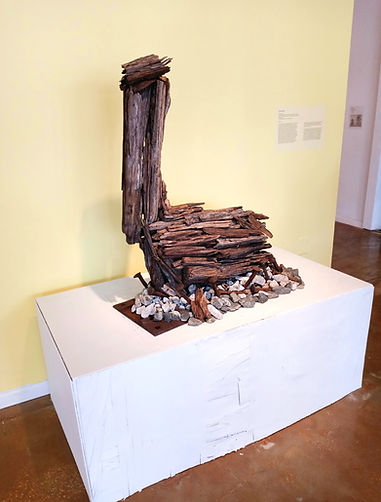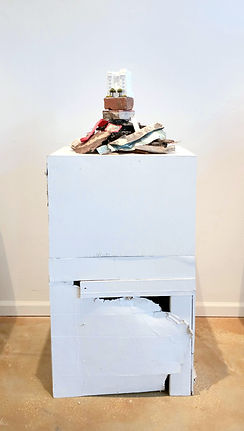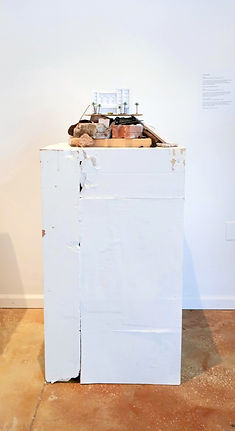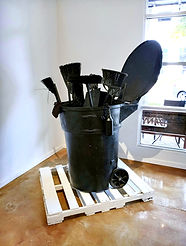Sunshine City (2020)
- Morean Arts Center, St. Petersburg, FL // July, 11th - September, 25th

_edited.jpg)
_edited.jpg)
_edited.jpg)
Pelican
old wooden railroad ties, railroad spikes, railroad rocks, found wood, eco friendly white paint, screws, wood glue, and railroad metal fasteners
*all materials collected in St. Petersburg, FL*
On June 8th, 1888, a Russian immigrant by the name of Peter Demens brought the Orange Belt Railway to the Tampa Bay area. He then named the land St. Petersburg after the city in Russia where he was born. The new railroad was glorified and brought passengers to a beautiful tourist destination on the water. However, most people overlooked how poorly the workforce that paved the way to St. Pete was treated. Peter Demens is revered for “discovering” the city but little is said for the working class minority that physically built the railroad. In October, 1887, a group of angry workers went on strike because Demens’ withheld three weeks of wages. They even threatened to kill Demens because of the working conditions. Demens eventually borrowed the money from a friend to give the workers their deserved pay but many continued to work overtime without pay. A poverty-stricken social status forced these people to work in a situation of unjust behavior.
Surviving on low wages and enduring harsh working conditions, these working class people deserve recognition for their determination and the pivotal role they played in paving the way for St. Petersburg.
To provide context, Brown Pelicans were first noticed when the Orange Belt Railway Pier extension was completed as many tourists looking to fish shared the pier with these mighty birds. Since then, the Brown Pelican has been the St. Petersburg’s unofficial bird and it’s imagery has made it into the city’s logo since 1927. It also served as the mascot for the segregated Black American baseball team known as the St. Petersburg Pelicans (one of 8 segregated teams in the state between the 1940s and 50s). In January of 2020, St. Petersburg made the pelican it’s official city bird after a century-long relationship.
_edited.jpg)
_edited.jpg)
_edited.jpg)
_edited.jpg)
_edited.jpg)
_edited.jpg)
_edited.jpg)
Prime Real Estate (Rubble) Series
Prime Real Estate (Rubble) Series consists of three artworks. Arranged from left to right they read Saltaire, Delmar 745, and the Artistry Apartments. The rubble that sits atop each pedestal was collected from various sites that have been torn down to make room for new developments in St. Petersburg this year (2020). Each pile is topped with an architectural model of the new apartments or buildings. The Delmar is paired with objects from the recent demolition site of the Pine Oak Mobile Home Park previously located on 4th street and 40th Avenue North. Residents of the mobile home park were given one year to leave but many assumed it was a false warning because no official paperwork was filed or presented to the residents. In January of 2020, the demolition team began destroying people’s homes, many of which still contained resident’s personal belongings. The demolition left some people houseless and caused families and individuals to live in cars and hotels until they could find an affordable place to live.
Saltaire
sourced rubble from the construction site of the development going up in 2020, glue, foam board, white plastic sheets, clear plastic sheets, eco friendly white paint, found wood, tiny fabricated grass, palm trees, tress, and bushes.
Delmar
sourced rubble from Pine Oak Mobile Homes site, glue, foam board, white plastic sheets, clear plastic sheets, eco friendly white paint, found wood, tiny fabricated grass, tress, and bushes.
Artistry Apartments
sourced rubble from the construction site of the development going up in 2020, glue, foam board, white plastic sheets, clear plastic sheets, eco friendly white paint, found wood, tiny fabricated grass, palm trees, tress, and bushes.
_edited.jpg)
_edited.jpg)
_edited.jpg)
_edited.jpg)
116 Days in 1968
St. Petersburg trash can, mops, brooms, sponges, cardboard, napkins, towels, spray bottle, black paint, found wood pallet, and eco friendly white paint
On May 6 of 1968, Joseph (Joe) Savage led a sanitation strike after St. Petersburg’s Sanitation Department failed to provide economic promises to employees who were forced to work a 48-hour work week. The next day, 52 workers were terminated for refusing to go to work. Eventually, 211 sanitation workers were fired over a strike period of about 4 months. It’s important to note that 210 of these mistreated workers were Black Americans. During this time period, the Civil Rights Movement inspired many people, including sanitation workers, to protest for their rights on a national scale. Historically, the Labor Movement aligned with the Civil Rights Movement because many working class citizens were and are still people of color.
On August 30th, St. Petersburg’s City Manager, Lynn Andrews proposed a settlement after four days of riots which ensued in response to the battery and arrest of a citizen who defaced a racially insensitive mural in City Hall. The settlement was lackluster, as it only rehired the fired workers as new employees. This caused former employees to lose sick days, vacation time, and seniority. The sanitation Department continued to demand 48-hour work weeks but promised that if a crew finished early they could leave with a full day’s pay. This was often too difficult to accomplish. The settlement also included a pay increase of $0.08 per hour, which was far from the $0.25 increase proposed by workers.
_JPG.jpg)
_JPG.jpg)
_edited.jpg)
Green Bench
sourced used wood from behind St. Petersburg's segregation line, fencing wood slats, screws, nails, eco friendly white paint, and green paint.
At one point, St. Petersburg was known as the city with “green benches.” Today, many local residents still recognize the green bench as a symbol of the city but continue to overlook the social and immoral implications of the bench's history. In the early 1900s, St. Petersburg became a popular tourist destination with a booming Central Avenue. To offer tourists the opportunity to enjoy the city’s energy, a variety of benches provided seating outside of restaurants and storefronts. In 1916, Mayor Al Lang decided to create an ordinance that mandated the size and color of these benches making them green across the board. However, these green benches were not experienced by everyone. They were exclusively located in the white portion of the city which meant that people of color were not able to access them during this era of segregation and racial tension. It also meant that people of color could not embrace the city’s leisure activities and in turn, the benches. This was unfortunate as many people of color worked in the city as servers, maintenance workers, cleaners, and all manner of working class jobs. Just as it did in the past, the green bench continues to symbolize the unrest, racial divisions, and social ideologies that plagued the city during its conception.
_.jpg)
_.jpg)
_.jpg)
_.jpg)
_.jpg)

For the ‘Unskilled’ Laborer
$8.56, mop rope head collected from the maintenance team at St. Petersburg’s City Hall, clear epoxy resin, and bucket handle
Florida’s minimum wage is now $8.56 in 2020. This amount borders the national minimum wage of $7.25. In Florida, there is often a significant disparity between paid wages and the living wage. For example, St. Petersburg’s estimated living wage is $12.57. This gap is commonly the core issue for working class people around the United States. Most working class citizens can’t afford to provide for their families on minimum wage. In addition to being underpaid, the working class often goes unseen, struggling as invisible and under appreciated members of society.
The mop head was graciously donated to the artist by the maintenance team at St. Petersburg’s City Hall.





City Limits (A Beach Facade)
sand collected from St. Petersburg beach, dirt collected from various places in St. Petersburg, broom, rake, shovel, plywood and plastic framing
City Limits takes the shape St. Petersburg, Florida. Filled with sand and toy-like tools, this piece playfully addresses the city’s identity as a tourist hub while undeserving it’s residential community. St. Pete has built a facade around the beach and usually caters to the tourism that stimulates the economy rather than uplifting the people that maintain it. Tools pull back pristine layers of sand to reveal unfortunate and ugly truths as well as social class distinctions. It also uncovers the layered complexity of St. Petersburg’s history. In areas of the sand pit, dirt mixes with sand signifying a unification of people and hopefully a brighter future for St. Petersburg's working class.






_edited.jpg)

“Greetings from St. Petersburg!”
cardstock paper, tea, coffee, colored pencil, and ink.
To create this series, postcards were sent to working class residents and frontline staff in St.Petersburg. Each person who penned a postcard was asked to reflect on their experiences and feelings towards working or living in St. Petersburg during the Coronavirus Crisis. This global occurrence has shifted the world’s perspective on working class individuals and has brought to light the essential nature of service work in our communities. Archival postcards from St. Petersburg’s history as a city fueled by the hospitality and tourism business inspired each work. Each image, carefully created by the artist, also takes into account the individual responses of those who contributed.
Each person who contributed a response chose an organization to which full artist proceeds will go if purchased.
-
Metropolitan Ministries
-
The Okra Project
-
Center for Disaster Philanthropy Covid-19 Response Fund
-
(F)empower Community Bond Fund
-
Black Lives Matter
-
Direct Relief
-
Tampa Bay Action Collective
Being born a resident of Pinellas County, Merada holds St. Petersburg close to his heart. For Sunshine City, he examines both popularized and forgotten histories of St. Pete’s past to critique and comment on the treatment of working class individuals throughout the history of his hometown. Some of the artworks take on specific historical references, from the segregated green benches of the 1920s to the sanitation strike of 1968. Others create conversation around current injustices of the working class, such as Florida’s low minimum wages, increasing developments, exemplified damages of the coronavirus pandemic, and at large classism and racism. Merada thinks art should have educational value and strives to create artworks that generate conversation, employ empathy, and contain educational integrity.
-Thank You-
“Thank you to all the essential workers, healthcare workers, community organization leaders, volunteers, donators, and activists. In this time we need to appreciate our community and those that fight for the oppressed. Please wear a mask in public spaces to not only protect you and your family but also the frontline workers around you. Thank you to Amanda Cooper for this incredible opportunity with an institution I truly care about. Thank you to Ora Fraze and the Fraze family for providing me a space to work. Thank you to my incredible family for the help and support. Last, but certainly not least, thank you to my amazing partner Jenna Canals for the help, inspiration, support, dedication, and love.”


